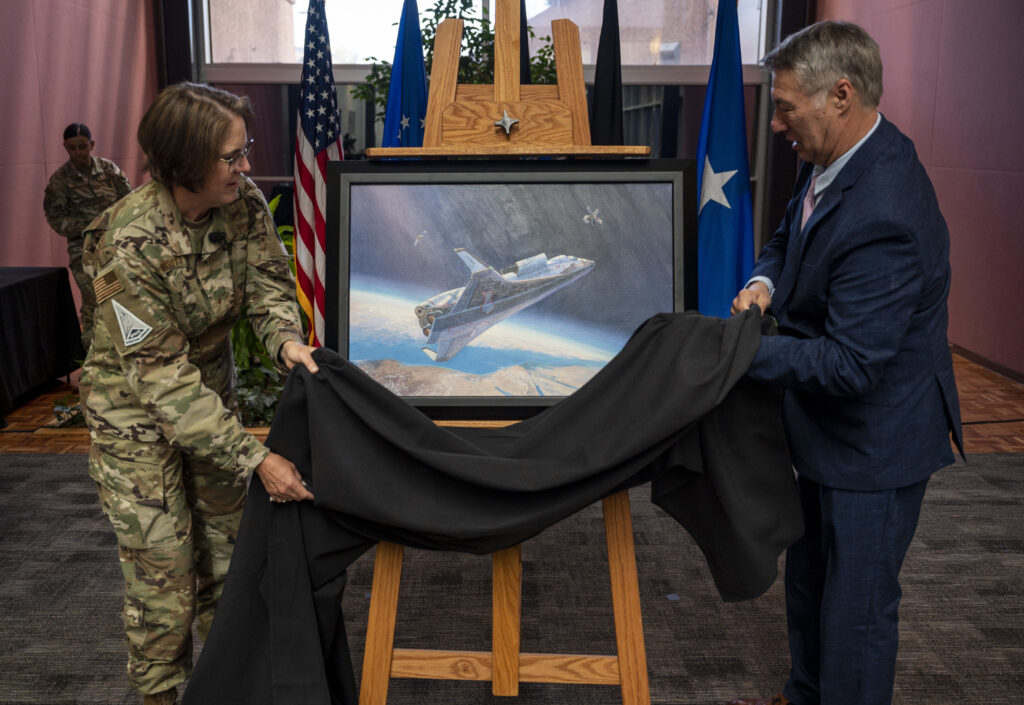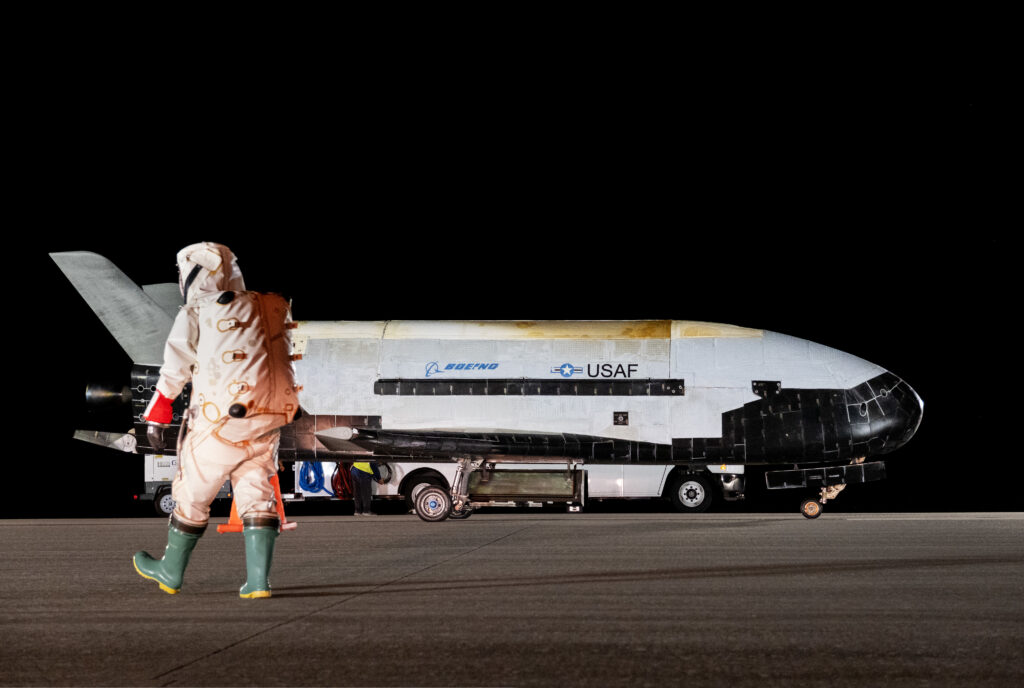The Space Force’s Space Operations Command (SpOC) unveiled the branch’s first official painting earlier this week, offering a tantalizing glimpse into the future of space combat operations. The painting by Rick Herter, titled High Ground Intercept, shows a futuristic American spacecraft hunting down an orbital weapon system before it can reach a nearby American satellite.
“The artwork depicts a futuristic U.S. Space vehicle intercepting an adversary satellite, who in turn is positioning to disable a friendly satellite,” a Space Force release explains before clarifying that the unusual spacecraft depicted is not representative of an actual program underway.

“Because of the highly classified nature of many space operations, SpOC requested that Herter rely on historic space planes and his own imagination,” explained Christopher Rumley, command historian. Those historic space planes used as reference material include the now-legendary Boeing X-20 Dyna-Soar, which was a hypersonic sub-orbital bomber already in active development prior to the launch of Sputnik 1 all the way back in 1957. The program matured to the point of a full-scale mock-up being built and a crew being selected that included a young Neil Armstrong, who would eventually leave the Dyna-Soar program in favor of higher altitudes with NASA.
While the Space Force was happy to acknowledge the X-20’s influence on this painting, arguably the spacecraft depicted closer resembles a much more modern platform that, despite being in service with the Space Force today, remains shrouded in a great deal of secrecy: the unmanned mini-space shuttle known as the X-37B.
Sandboxx News has discussed the X-37B in the past, highlighting its potential value as America’s most useful spy satellite. Today, the engineering and development cycle inherent to deploying a new spy satellite usually takes about 10 years from design to orbit, meaning a new spy satellite launched today is already carrying outdated equipment. The X-37B, on the other hand, can come down from orbit and land, have its sensor payload swapped out, and be launched right back into orbit.
The X-37B is a long-duration spacecraft, meaning it can stay in orbit for long periods of time and currently has a record of 908 days in orbit. Further, its ability to carry cutting-edge sensors, as well as the orbital mobility allotted by its onboard thrusters, make the X-37B a very difficult intelligence asset to plan against. That isn’t lost on America’s competition, of course, and China is hard at work on its own apparent copy of the platform.

However, this painting might hint at another vital role the X-37B may already be able to fill for the American defense apparatus. Far from the science fiction depictions of space warfare we’ve come to embrace in pop culture, actual satellite warfare doesn’t need to involve phasers or photon torpedoes. Instead, compromising a nation’s missile warning, communications, or other satellite-based capabilities could be done simply by nudging a satellite into a degrading orbit that results in it burning up upon re-entry.
To that end, both Russia and China have been accused of fielding orbital systems – often called inspector satellites – designed for this very function. These maneuverable satellites could use any number of simple mechanisms to attack America’s vulnerable orbital assets that were largely fielded during a time when America had very little competition in low earth orbit, and as such, its satellites were not hardened against attack.
As former Air Force Secretary Heather Wilson once put it, the United States “built a glass house before the invention of stones.”
As depicted in this painting, the X-37B (or a similar spacecraft) could be tasked with intercepting these inspector satellites as they close with other orbital assets, engaging them with similar simplicity – using a grabbing arm or similar mechanism to pull, push, or otherwise send the enemy craft off course.
A test from the RemoveDEBRIS program showed how a satellite could capture junk floating in orbit, but it also demonstrated just how easy it would be to capture something that isn’t junk.
This approach, while less dramatic than launching anti-satellite missiles, reduces the possibility that a destroyed satellite could produce a fast-moving debris cloud that would engulf other satellites in a cascade that’s sometimes called the Kessler Syndrome. As a result, most countries have moved away from the idea of launching missiles at satellites simply due to the risk of their own satellites being damaged by the debris that would result.
This new Space Force artwork will eventually find its way into the Department of the Air Force Art Collection, which maintains thousands of pieces of art meant to commemorate the service of Airmen – and now Guardians.
Read more from Sandboxx News
- Watch: Israeli Navy SEALs recapture base from Hamas terrorists
- America’s new stealth bomber begins taxi tests ahead of first flight
- The MKC Hellgate is a fantastic hatchet for deployment
- Russia’s armored trains: Major vulnerability or smart warfare?
- Spy satellites aren’t nearly as all-seeing as you think


